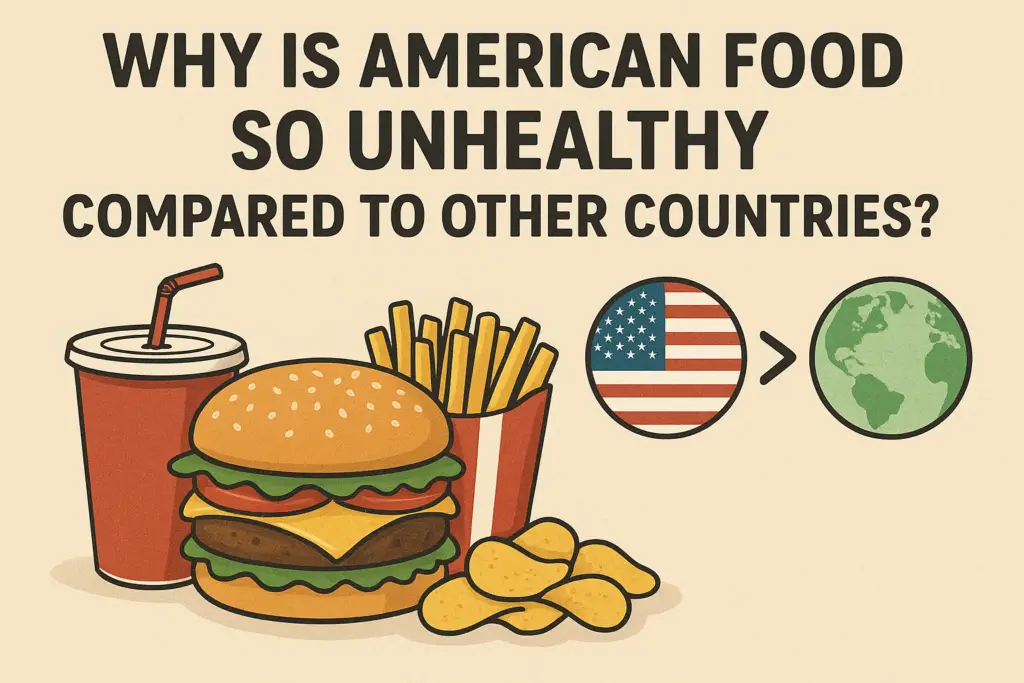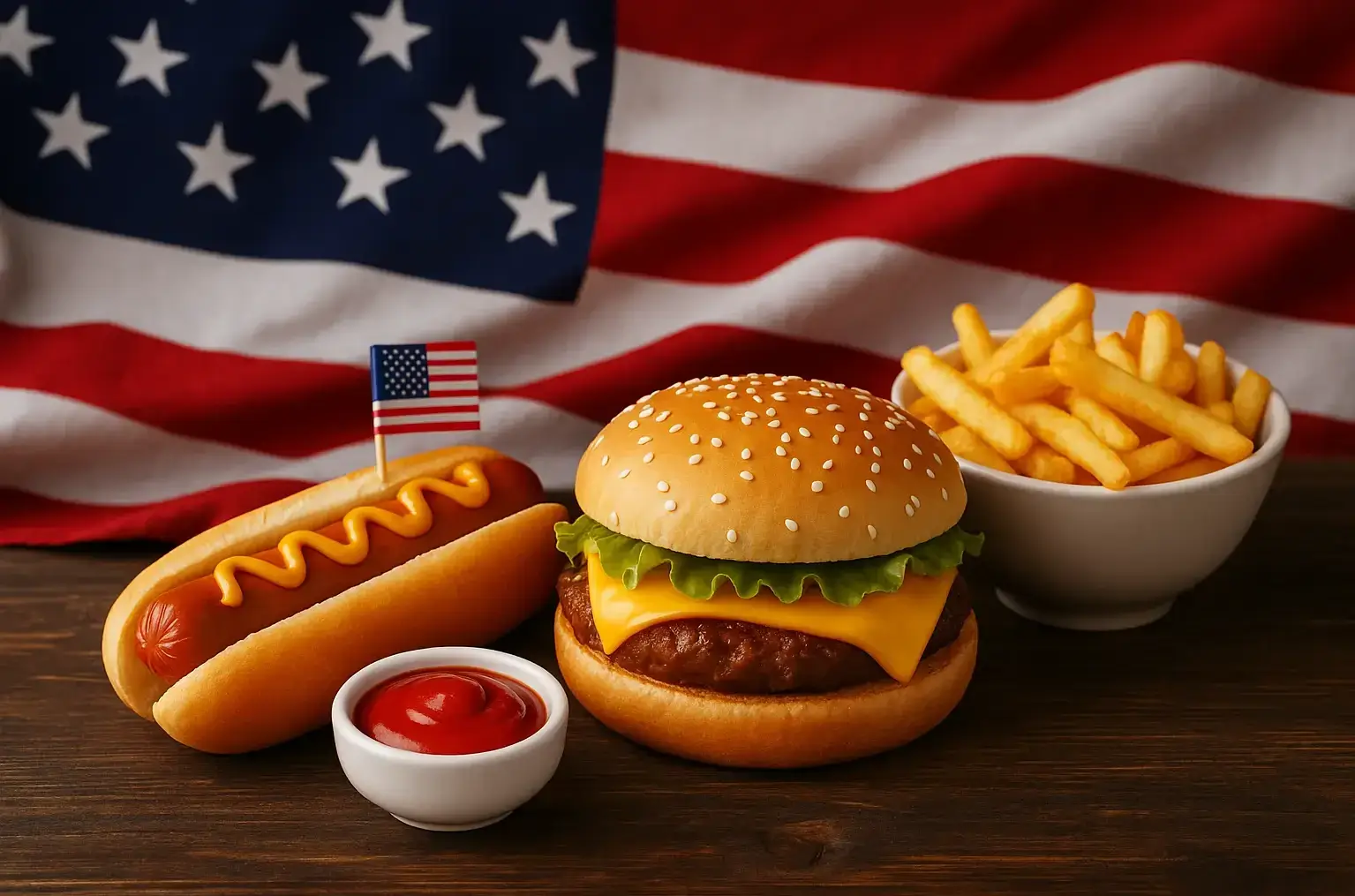11, Sep 2025
Why is American Food So Unhealthy Compared to Other Countries

Introduction
Why is American food so unhealthy compared to other countries? That’s the kind of question that makes you pause mid-meal and really think about what’s happening on your plate. I’ve seen how food in the U.S. has morphed into a whirlwind of convenience, massive portions, and ultra-processed options—yet somehow, we carry some of the highest obesity and chronic disease rates in the world. It’s almost like an outdated system running in the background, never upgraded, while other countries shifted toward fresher, more balanced eating traditions. The real puzzle is how we got here, why the cycle continues, and what lessons we might borrow from places that figured out healthier food cultures.
Why are portion sizes in America so much larger than in other countries
Walk into almost any American restaurant, and you’ll notice the serving sizes are massive compared to Europe or Asia. A plate of pasta in Italy might be modest—just enough to satisfy—but in the U.S., the same dish is often double or even triple the amount. This cultural expectation for “value for money” encourages bigger portions, which directly leads to higher calorie consumption without people even realizing it.
Studies show that people tend to eat more when served more, regardless of hunger cues. That’s why a supersized soda or bucket of popcorn doesn’t just sit untouched—it gets finished. In many countries abroad, portions are designed to satisfy rather than overwhelm, making moderation part of the eating experience.
Another factor is marketing. American restaurants often advertise “all you can eat” or combo deals, which normalize overeating. Meanwhile, in countries like Japan or France, portion control is tied to cultural norms of balance, quality, and enjoyment.
How does the American reliance on processed foods affect health
The U.S. food system is dominated by processed and ultra-processed products. From breakfast cereals to frozen dinners, convenience has replaced fresh preparation. While these foods save time, they come with hidden costs—high levels of sugar, sodium, unhealthy fats, and artificial additives that contribute to chronic illnesses like diabetes and hypertension.
Compare that to countries where home-cooked meals are still the norm. In Mediterranean cultures, for example, olive oil, vegetables, legumes, and lean proteins form the backbone of daily meals. The difference in nutrient density is staggering. In America, quick fixes rule the shelves, but they leave people nutrient-deficient and energy-drained.
Marketing plays a role too. Processed foods are aggressively advertised to families and kids, often dressed up as healthy when they’re anything but. Other nations regulate this more strictly, keeping harmful products from dominating the dinner table.
What role do fast food chains play in shaping American diets
Fast food is woven into American culture more than almost anywhere else. Chains like McDonald’s, Burger King, and Taco Bell became global icons, but their strongest grip remains at home. With low prices, drive-thru access, and familiarity, fast food became a daily staple rather than an occasional treat.
The impact is massive. Burgers, fries, and sugary drinks make up a large share of the typical American diet. The issue isn’t just frequency but also normalization—grabbing a fast-food meal is seen as routine rather than indulgent. Abroad, these chains exist but usually as special-occasion stops, not everyday choices.
Interestingly, when these same companies operate in Europe or Asia, they often adapt menus to fit local tastes—lighter options, smaller sizes, or fresher ingredients. In the U.S., though, the focus remains on bigger, cheaper, and faster.
Why do European diets emphasize fresh and local ingredients
In many European countries, markets overflow with fresh fruits, vegetables, cheeses, and breads—all sourced locally. Shopping several times a week is normal, and meals are prepared with seasonal produce. This cultural rhythm emphasizes freshness, flavor, and nutrition.
In contrast, American households rely heavily on supermarkets stocked with packaged goods designed to last weeks or months. The idea of daily market shopping feels inconvenient, but that trade-off often means sacrificing nutrient quality.
Eating in Europe is also more ritualistic. Meals are social occasions meant to be savored. That slower pace naturally reduces overeating. In the U.S., eating is often rushed, done on the go, or multitasked—leading to poor digestion and a lack of connection to what’s being consumed.
How does the American food industry influence eating habits
The food industry in America is a powerhouse, with billions spent on advertising each year. Processed snacks, sodas, and fast food dominate TV, digital platforms, and even schools. Children grow up associating bright packaging and catchy slogans with “fun” food, setting lifelong habits early.
Lobbying also plays a big role. The industry influences government dietary guidelines and policy, often prioritizing profits over public health. That means unhealthy ingredients stay cheap and widely available, while healthier alternatives remain costly and less accessible.
In other countries, stricter regulations and cultural pushback keep industry influence more balanced. For instance, the EU bans certain additives and enforces stricter labeling laws. The U.S. food industry, on the other hand, thrives on convenience culture, reshaping eating habits in its image.
What cultural attitudes toward food make Americans eat differently
In America, food is often tied to speed, convenience, and affordability. Meals happen in cars, at desks, or while watching TV. Food is fuel, not necessarily an experience. Compare that to Italy, where meals are sacred family rituals, or Japan, where presentation and mindfulness elevate even a simple dish.
This difference in mindset changes everything. Americans view bigger portions as generosity, while Europeans often see them as wasteful. Americans embrace “quick bites,” while other cultures linger over multi-course meals. This cultural gap helps explain why overeating and poor nutrition are normalized in the U.S.
Another factor is body image and dieting culture. Paradoxically, while Americans are surrounded by unhealthy food, they are also bombarded with “quick fix” diet trends. This creates a cycle of indulgence and restriction, rather than long-term healthy eating habits.
How do government policies impact food quality in the United States
Government policies shape the food landscape more than most people realize. In the U.S., subsidies heavily favor corn, soy, and wheat—staples of processed foods and animal feed. That makes sugary drinks, fried foods, and cheap meat more affordable than fresh produce.
Meanwhile, safety regulations allow additives and chemicals banned in other countries. For example, Europe has stricter rules on food dyes, preservatives, and hormones in meat. In the U.S., many of these substances remain widely used, even with health concerns attached.
Other countries prioritize public health in policy-making. For example, several European nations impose taxes on sugary drinks or restrict junk food advertising to children. The U.S. lags behind in such initiatives, often due to industry lobbying.
Why are obesity and chronic disease rates higher in the US
America leads the world in obesity and related conditions like type 2 diabetes, heart disease, and hypertension. The reasons go beyond just food—it’s the combination of oversized portions, processed diets, sedentary lifestyles, and stress-heavy environments.
What’s striking is how preventable many of these conditions are. Countries with healthier diets and active cultures show far lower rates of obesity, even when income levels are comparable. For instance, Japan and Mediterranean nations balance food choices with movement and tradition, keeping rates much lower.
The U.S. healthcare system also focuses more on treatment than prevention, which means lifestyle changes aren’t prioritized until health problems already exist.
How does socioeconomic status affect food choices in America
Food inequality is another piece of the puzzle. In wealthier neighborhoods, organic markets, farm-to-table restaurants, and boutique health stores thrive. Meanwhile, in lower-income areas, fresh produce is scarce, and fast food outlets dominate. This creates “food deserts” where unhealthy options are the default.
Time also plays a role. Families juggling multiple jobs may rely on fast food or pre-packaged meals for convenience. Healthier cooking requires time, knowledge, and access that aren’t always available.
In other countries, governments often step in to ensure broader access to fresh and affordable foods. In the U.S., the gap continues to widen, reinforcing cycles of poor health in vulnerable communities.
What lessons can Americans learn from healthier food cultures abroad
Looking abroad offers hope and inspiration. From the Mediterranean’s olive oil and fish-heavy diet to Japan’s portion control and vegetable-forward meals, there are plenty of models worth adapting. The key lesson is balance—freshness, variety, and mindfulness over quantity and speed.
Americans can benefit from embracing cultural food rituals, slowing down meals, and prioritizing seasonal produce. Even small shifts, like swapping soda for water or preparing one home-cooked meal a day, can spark change.
Adapting these lessons doesn’t mean abandoning American identity. Instead, it’s about creating a hybrid approach that blends convenience with health, affordability with nutrition, and individual choice with collective well-being.
Conclusion
So, why is American food so unhealthy compared to other countries? The answer lies in a mix of culture, policy, industry, and lifestyle. Oversized portions, processed foods, aggressive marketing, and a fast-paced culture all contribute to a health crisis that other nations manage to avoid.
But change is possible. By learning from healthier food traditions abroad and questioning the outdated “algorithm” that shaped American eating habits, we can start to rebuild a system that fuels health instead of harming it.
🍽️ What do you think—have you noticed differences in food when traveling abroad? Drop a comment, share this post with friends, and let’s start a conversation about rethinking how we eat.
FAQ:
Is fast food the main reason American food is unhealthy?
Fast food plays a huge role, but it’s not the only factor. Oversized portions, heavy reliance on processed ingredients, and aggressive food marketing also contribute. While fast food is an obvious culprit, everyday supermarket items—like sugary cereals, frozen dinners, and soda—are equally responsible for poor health outcomes.
Why do Americans eat more processed food than other countries?
Convenience and affordability drive the American preference for processed food. Government subsidies make refined grains, corn syrup, and processed meats cheap, while fresh produce is often more expensive. Busy lifestyles also make “ready-to-eat” options appealing, creating a cycle where processed food becomes the default choice.
How do portion sizes affect American health?
Portion sizes in the U.S. are significantly larger than in most other countries. Research shows that people naturally eat more when given more, even if they aren’t hungrier. Over time, oversized portions normalize overeating, leading to weight gain and increased risk of chronic illnesses.
Are American food additives banned in other countries?
Yes, many additives and chemicals allowed in U.S. foods are banned abroad. For example, certain artificial dyes, preservatives, and growth hormones are restricted in the EU and other regions due to health risks. In the U.S., food industry lobbying has slowed regulatory changes, keeping these additives legal and widely used.
Do cultural attitudes make a difference in eating habits?
Absolutely. In countries like Italy, France, or Japan, meals are social rituals centered on quality and balance. In America, food is often seen as fast, convenient fuel. This cultural difference affects everything from portion size expectations to how often people eat processed versus fresh food.
What role does socioeconomic status play in unhealthy eating?
Lower-income families often face “food deserts” where affordable, healthy options are scarce. Fast food and processed items are cheaper and more accessible, making them the default. Higher-income areas typically have access to organic stores and fresh markets, creating a sharp divide in food quality and health outcomes.
Can Americans realistically change their eating habits?
Yes, but it requires systemic and cultural shifts. On an individual level, small changes—like reducing soda intake, cooking at home, or choosing smaller portions—make a difference. On a larger scale, policy reforms, better food education, and industry accountability will help Americans shift toward healthier eating patterns.
What lessons can Americans learn from other countries?
Americans can adopt practices like smaller portion sizes, daily fresh produce, and making meals a social experience rather than a rushed task. The Mediterranean diet, Japanese portion control, and French emphasis on balance are examples worth learning from. These lessons can improve both health and the overall relationship with food.
- 0
- By Pankajatray
- September 11, 2025 20:06 PM

